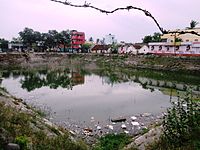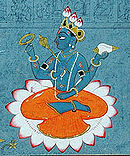
Nammalvar was one of the twelve Alvar saints of Tamil Nadu, India, who are known for their affiliation to the Vaishnava tradition of Hinduism. The verses of the Alvars are compiled as the Naalayira Divya Prabandham, where praises are sung of 108 temples that are classified as divine realms, called the Divya Desams. Nammalvar is considered to be the fifth in the line of the twelve Alvars. He is highly regarded as a great mystic of the Vaishnava tradition. He is also considered to be the foremost among the twelve Alvars, and his contributions amount to 1352 among the 4000 stanzas in the Naalayira Divya Prabandam.

The Alvars were the Tamil poet-saints of South India who espoused bhakti (devotion) to the Hindu preserver deity Vishnu, in their songs of longing, ecstasy, and service. They are venerated in Vaishnavism, which regards Vishnu as the Ultimate Reality.

A Divya Desam or Vaishnava Divya Desam is one of the 108 Vishnu and Lakshmi temples that is mentioned in the works of the Alvars, the poet-saints of the Sri Vaishnava tradition.

Alagiya Manavalan, best known by his epithet Manavala Mamunigallit. 'The great saint, Manavalan' (1370–1450), was a Hindu theologian. He was a major proponent of the Sri Vaishnavism tradition in the 15th century in Tamilakam, disseminating it with the help of his eight disciples. The disciples of Manavalan established places of learning to teach the Vishishtadvaita philosophy in Tamilakam.

Bhoothath Alvar is one of the twelve Alvar saints of South India, who were known for their affiliation to the Vaishnava tradition of Hinduism. The verses of Alvars are compiled as Nalayira Divya Prabandham and the 108 temples revered are classified as Divya Desams. Bhoothath is considered second in the list of the three principal Alvars, with the other two being Poigai Alvar and Pey Alvar, collectively called Mutalamalvargal who are known to be born out of divinity. Bhoothath composed hundred verses that are classified as Irantam Tiruvantati and his composition is set in the antati style in which the ending syllable is the starting one for the next verse.
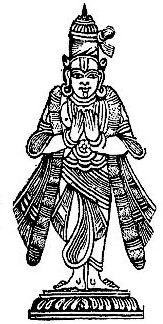
Pey Alvar is one of the twelve Alvar saints of South India, who are known for their affiliation to Vaishnava tradition of Hinduism. The verses of Alvars are compiled as Nalayira Divya Prabandham and the 108 temples revered are classified as Divya Desams. Pey Alvar is considered third in the list of the three principal Alvars, with the other two being Poigai Alvar and Bhoothath Alvar, collectively called Mutalamalvargal who are known to be born out of divinity. Pey Alvar composed hundred verses that are classified as Munram Tiruvantati and his composition is set in the antati style in which the ending syllable is the starting one for the next verse.
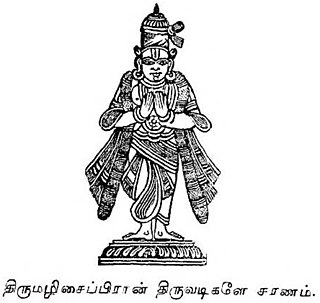
Tirumalisai Alvar is a Tamil saint revered in the Sri Vaishnavism school of south India, in Tondai Nadu. He was born in 4203 BCE. The legend of this saint devotees of Sri Vaishnavism believe that he was the incarnation of Vishnu's disc, Sudarshana. He is believed to have been born at the Jagannatha Perumal temple, Tirumalisai, by "divine grace".
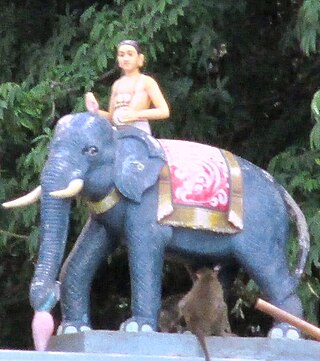
Periyalvar, also known as Vishnuchittar, was one of the twelve Alvar saints of South India who are known for their affiliation to the Vaishnava tradition of Hinduism. He was the foster father of Andal. Andal, also called as Kodhai, is the only female Alvar, and is considered to be the incarnation of Bhudevi according to Sri Vaishnavism.

Thondaradippodi Alvar or Vipra Narayana was one of the twelve Alvar saints of South India, who are known for their affiliation to Vaishnava tradition of Hinduism. The verses of Alvars are compiled as Naalayira Divya Prabandham and the 108 temples revered are classified as Divya desam. Thondaripodi is considered the tenth in the line of the twelve Alvars.

Thirumangai Alvar, also referred to as Thirumangai Mannan is the last of the 12 Alvar saints of south India, who are known for their affiliation to the Vaishnava tradition of Hinduism. He is considered one of the most learned Alvars, and the most superior Alvar in the context of composition of verses. He holds the title Narkavi Perumal, the mark of an excellent poet, and Parakala.

Tirukoilur also spelt as Tirukkoyilur or Tirukovilur is a city and the headquarters of Tirukoilur taluk in Kallakurichi District, Tamil Nadu, India. The town is located on the southern bank of Thenpennai River and famous for Ulagalantha Perumal TempleTirukoilur is located on the highway connecting cities of Tiruvannamalai and Vellore with Southern Tamil Nadu. The town is served by Tirukoilur railway station.

The Ashtabujakaram or Ashtabuja Perumal Temple located in Kanchipuram in the South Indian state of Tamil Nadu, is dedicated to the Hindu god Vishnu. Constructed in the Dravidian style of architecture, the temple is glorified in the Nalayira Divya Prabandham, the early medieval Tamil canon of the Alvar saints from the 6th–9th centuries CE. It is one of the 108 Divya Desams dedicated to Vishnu, who is worshipped as Ashta Bhuja Perumal and his consort Lakshmi as Alamelumangai.

Tiruvekkaa Temple or Yathothkari Perumal Temple is a Hindu temple located in Kanchipuram in the South Indian state of Tamil Nadu and dedicated to the Hindu god Vishnu. Constructed in the Dravidian style of architecture, the temple is glorified in the Naalayira Divya Prabandham, the early medieval Tamil canon of the Alvar saints from the 6th–9th centuries CE. It is one of the 108 Divya Desams dedicated to Vishnu, who is worshipped as Yathothkari Perumal, and his consort Lakshmi as Komalavalli.
Tiruppan Alvar was one of the twelve Alvars of South India, who were poet-saints known for their affiliation to the Sri Vaishnava tradition of Hinduism. The verses of the Alvars are compiled as the Naalayira Divya Prabandham and the 108 temples revered in the text are classified as Divya Desams. Tiruppan Alvar is considered the eleventh in the line of the twelve Alvars.
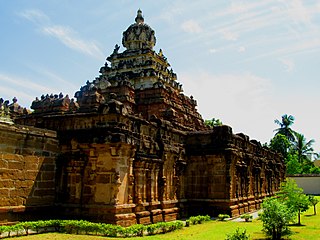
Thiru Parameswara Vinnagaram or Vaikunta Perumal Temple is a temple dedicated to Vishnu, located in Kanchipuram in the South Indian state of Tamil Nadu. Constructed in the Dravidian style of architecture, the temple is glorified in the Nalayira Divya Prabandham, the early medieval Tamil canon of the Alvar saints from the 6th through the 9th centuries CE. It is one among the 108 Divya Desams dedicated to Vishnu, who is worshipped as Vaikuntanathan and his consort Lakshmi as Sri Vaikundavalli. The temple is considered as the oldest extant temple in Kanchipuram.

Pandavatutar Perumal Temple or Thirupadagam located in Kanchipuram in the South Indian state of Tamil Nadu, is dedicated to the Hindu god Krishna, an avatar of the god Vishnu. Constructed in the Dravidian style of architecture, the temple is glorified in the Nalayira Divya Prabandham, the early medieval Tamil canon of the Alvar saints from the 6th–9th centuries CE. It is one of the 108 Divya Desams dedicated to Vishnu, who is worshipped as Pandava Tutar Perumal (Krishna) and his consort Lakshmi as Rukmini, Krishna's principal wife.

Ulagalantha Perumal Temple or Trivikrama Temple is a Hindu temple dedicated to Vishnu located in Tirukkoyilur, Tamil Nadu, India. Constructed in the Dravidian style of architecture, the temple is glorified in the Naalayira Divya Prabandham, the early medieval Tamil canon of the Alvar saints from the 6th–9th centuries CE. It is one of the 108 Divya Desams dedicated to Vishnu, who is worshipped as Ulagalantha Perumal and his consort Lakshmi as Poongothai. The temple is believed to have been built by the Medieval Cholas, with later contributions from Vijayanagara kings and Madurai Nayaks. The temple covers an area of 5 acres (20,000 m2) and has a temple tower that is the third tallest in Tamil Nadu, measuring 192 ft (59 m) in height.

Thiruvaragunamangai Perumal Temple is one of the Nava Tirupati, the nine Hindu temples dedicated to Vishnu located in the Tiruchendur-Tirunelveli route, Tamil Nadu, India in the banks of Thamiraparani river. All these 9 temples are classified as Divya Desams, the 108 temples of Vishnu revered by the 12 poet-saints of the Sri Vaishnava tradition, called the Alvars. The temple at Natham also known Chandran Sthalam, the second of the Nava Tirupatis. Constructed in the Dravidian style of architecture, the temple is dedicated to Vishnu who is worshipped as Vijayasana Perumal and Lakshmi as Varagunavalli.
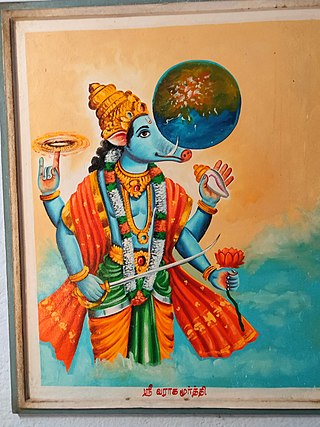
The Mutal Tiruvantati is a Tamil Hindu work of literature composed by Poigai Alvar, one of the twelve Alvars of Sri Vaishnavism. Comprising 100 verses in the poetic meter called the antati, it is part of the compendium of hymns called the Nalayira Divya Prabandham.

The Nanmukan Tiruvantati is a Tamil Hindu work of literature composed by Tirumalisai Alvar, one of the twelve Alvars of Sri Vaishnavism. Comprising 100 verses in the form of a poetic device known as the antati, it is part of the compendium of hymns called the Nalayira Divya Prabandham. It is dedicated to the preserver deity, Vishnu.

